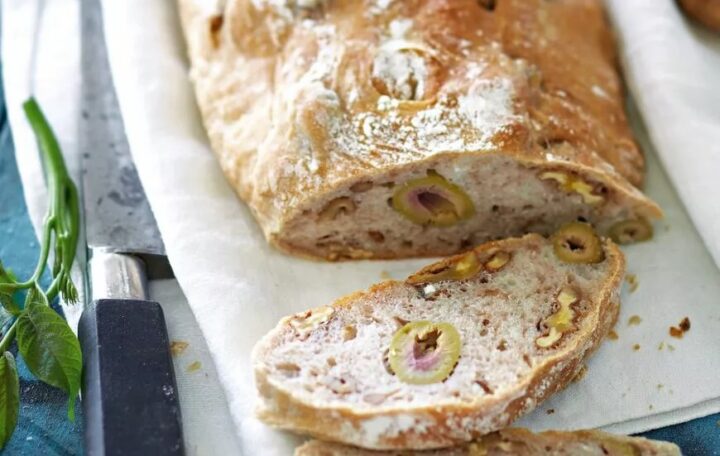
ciabatta with walnuts and olives: Recipe
We can’t get enough of this spelled ciabatta with walnuts and olives… / Ciabatta recipe
Would you like to bake a delicious and healthy ciabatta? Then our walnut and olive ciabatta is just right for you. Instead of wheat flour, we use nutrient-rich spelled flour. Perfect with a delicious dip or as a side dish to soup, salad, etc.
Recipe for delicious spelled ciabatta with walnuts and olives
Our delicious spelled ciabatta tastes wonderful as an evening meal with dip or spread, but also as a side dish with soup or salad. The best? Instead of wheat flour, we use spelled flour, which is rich in B vitamins, sodium, potassium and magnesium, among other things.
Ingredients
for 4 servings
450 g spelled flour (Type 630)
Salt
1 tsp fennel seeds (coarsely crushed)
1 packet of dry yeast
2 tbsp white wine vinegar
2 tbsp olive oil
100 g walnut kernels
50 g green olives (without stone)
Preparation
Mix spelled flour with 1 heaped teaspoon of salt, fennel and yeast in a bowl. Add 280ml lukewarm water and vinegar. Process everything into a smooth dough using a hand mixer (dough hook). Knead in oil. Cover and let the dough rest at room temperature for about 6 hours.
Roughly chop the walnuts and knead them into the dough with the olives. Form it into a loaf of bread and place it on a baking tray lined with baking paper. Dust lightly with a little flour. Cover the dough with a tea towel and let it rise at room temperature for another 60 minutes.
Preheat the oven to 220 degrees (fan oven 200 degrees). Place a cup of water on the bottom of the oven. Bake bread in the oven for about 35 minutes.
Tips for the recipe
For the large table: Double the ingredients and bake 2 loaves or 8 rolls. Once cooled, freeze well wrapped. Bake briefly in the oven before serving.
Spelled flour is so healthy
Spelled flour is becoming increasingly popular as an alternative to wheat flour. In contrast to wheat flour, it contains higher quality protein and more healthy nutrients. On top of that, spelled is rich in unsaturated fatty acids and fiber. The icing on the cake: Spelled generally tastes more aromatic and, in contrast to wheat flour, more nutty. For example, you can buy spelled flour here in a pack of 6 from Alnatura for 13.74 euros >>
If you are looking for more delicious recipes with spelled flour, you will find them in the book “Cake, Bread and Co. with Spelled” by Sabine Voshage. Available here for 8.99 euros >>
What you need to consider when baking with spelled
If you follow our recipe for the fluffy, soft spelled ciabatta with walnuts and olives, nothing can go wrong. In general, you should be careful when baking with spelled, because spelled flour behaves differently than wheat flour.
Water requirements : Spelled flour often absorbs more liquid than wheat flour. Therefore, you may need to add a little more water or liquid to give the dough the right consistency.
Gluten properties : Spelled flour contains less gluten than wheat flour , so the dough may be less elastic. This can mean that the dough doesn’t rise as well or that the end result is a little more compact. To compensate for this, you can add flour containing gluten, such as wheat or kamut flour, or use special baking products that support the gluten network.
Baking time : Spelled flour can tend to brown quicker than wheat flour. Therefore, when baking, make sure that your baked goods do not become too dark. It may be helpful to set the temperature slightly lower or shorten the baking time.
The biggest difference to conventional wheat flour is the taste . Spelled has a nutty, malty taste. Consider beforehand whether these particular flavors fit what you have in mind.
Categories: General
